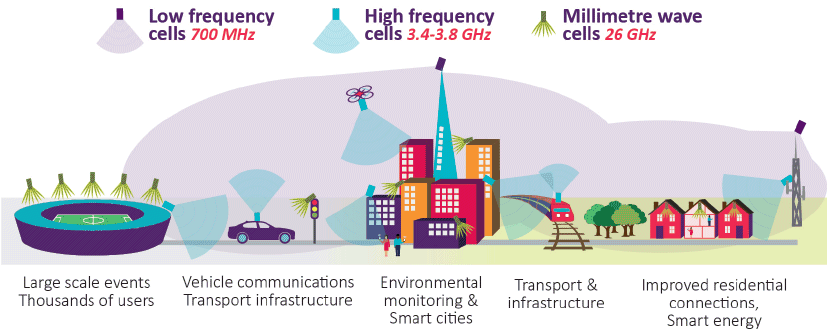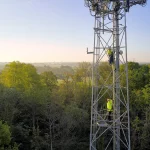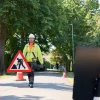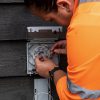IET Calls for the UK Gov to Plan for Reliable Universal 5G Mobile Coverage
The Institution of Engineering and Technology (IET) has today published a new report that makes 23 recommendations to help the Government roll-out future 5G Mobile services from 2020 and achieve “reliable universal coverage” of the United Kingdom by 2025. Easier said than done.
At present 5G is still very much a hype train, with talk of peak download speeds reaching 20Gbps (Gigabits per second), plus uploads of 10Gbps and 1ms (millisecond) latency times often blinding people to the complex realities of a future commercial deployment (cost, coverage, network capacity and the laws of physics etc.).
Professor Will Stewart, Vice President of the IET, said:
“5G has the potential to transform the UK economy, modernise industry and support the fast-growing digital social space so a bold and long-term strategy from Government is vital.
The biggest challenge will be improving coverage for all, as 5G cannot transform what it doesn’t cover. And achieving universal coverage for the UK, outside high-capacity urban areas, will not be affordable or achievable without regulatory change.
Ultimately, delivering 5G is not a flash in the pan to be achieved in 2020 but a journey demanding deep and sustained levels of cooperation between governments, regulators, operators, vendors and vertical industries.”
The technology itself remains firmly in the early R&D phase, with no final standards (expected 2018) or solidly defined radio spectrum bands to its name. Nevertheless London will soon play host to an early 5G trial (here) and Ofcom has also proposed that it could make use of radio spectrum in the 700MHz, 3.4-3.8GHz and the higher frequency 24.25-27.5GHz (26GHz) bands (here).
Advertisement

However in the real-world 5G faces many challenges and its hunger for higher frequencies will make it difficult to deliver ultrafast broadband speeds due to limited coverage, at least not without spending big on a much denser network of masts and base stations. This is something that operators may struggle to achieve, particularly if Ofcom prices the related spectrum too high and operators struggle to build new sites due to restrictions (planning permission, wayleaves etc.).
Similarly Ofcom’s understandable proposal to see 5G use the lower frequency 700MHz band for cheaply delivering wide coverage (e.g. rural areas) is all well and good, although data speeds would be significantly slower than in urban areas unless more spectrum is made available, such as for Carrier Aggregation (using multiple 5G bands at the same time) etc.
It’s into this climate that the IET, which is one of the largest engineering institutions with over 168,000 members in 150 countries, has thrust their new guide – ‘5G Networks for Policy Makers‘. The guide warns that network coverage (or lack of it) will be the big 5G policy headache but achieving strong universal reach would clearly be very expensive.
Advertisement
As such the guide calls on the Government and Ofcom to adopt a “bold and ambitious approach” in making the right decisions now in order to deliver the “world class digital infrastructure that consumers and business will need over the next decade.”
Key to all of this will be modernising the regulatory framework to reduce the cost of maximising coverage. The IET’s report suggests that this could be achieved by either encouraging more industry consolidation (Ofcom didn’t seem keen on that idea when O2 and Three UK attempted to merge), providing significant levels of public funding (the current Government is very Austerity minded) or changing the regulatory framework to allow things to be done differently in a way that brings down the cost.
The latter idea seems to be what the IET favours, which could see changes that would permit deeper Radio Access Network (RAN) sharing with Open Hosting, inversion of the site rental model and better ways to harness spare private small cell capacity in a more integrated way than current WiFi off-load. They also call for a longer business rates holiday for new infrastructure and many other things.
The UK Government has already set aside some funding for early 5G development, spectrum release and trials (Budget 2017), while the 2017 Digital Economy Act includes a revision to the Electronic Communications Code (ECC) that may make it cheaper and easier to roll-out new infrastructure (here), although there’s clearly still lots of room for improvement.
Advertisement
Lest we forget that existing 4G services are already able to offer ultrafast (100Mbps+) speeds, assuming the right network capacity and spectrum can be harnessed. However geographic 4G coverage is still expanding and even the most advanced operator – EE – only expects to reach 92% UK geographic coverage by September 2017, followed by 95% in 2020; that’s perhaps as close to universal coverage as we can feasibly get with the current model.
In all the guide makes 23 recommendations.
The Recommendations
BROAD POLICIES
Recommendation 1
The Government and Ofcom need to be ambitious, radical, and bold as the right decisions taken now will deliver the world class wireless digital infrastructure that consumers and businesses will find essential 7-10 years from now.Recommendation 2
The Governments approach to 5G should be based on the overall “5G fabric” and not just the new 5G component parts.Recommendation 3
The 5G fabric also includes the fixed network, fibre has a pivotal role and help must be given to its availability to support 5G at the right price, location, and time.Recommendation 4
The Government and Ofcom need to place “coverage maximisation” at the top of the list of priorities in driving the modernisation of the regulatory framework for 5G networks. Coverage is not just about getting a signal for a voice call anymore but getting the necessary “Quality of Coverage” for a thriving digital economy and Gb/s digital society.Recommendation 5
UK global leadership in 5G is likely to require a lot of thought on the part of the Government and Ofcom on the right combination of Government intervention, regulatory changes, industry co-operation, structural co-operation, competition, and market forces.Recommendation 6
The Government and Ofcom need to proactively sustain an engagement with Europe over 5G through and after Brexit.Recommendation 7
The Government should bring together a coalition of the willing to deliver the launch of 5G networks in the UK by 2020.GENERAL REGULATORY REFORMS
Recommendation 8
There will likely be a need to reconsider various aspects of regulation as connectivity blurs across cellular and Wi-Fi. For example, when assessing competition, regulators may need to consider broader definitions of relevant markets and a wider set of possible actors.Recommendation 9
The Passive Infrastructure Access issue (ducts, poles etc.) is complex, likely to be controversial but must be tackled by the Government and Ofcom to deliver the benefits of 5G to the largest number of consumers. The focus needs to be widened to include all public utility facility owners.Recommendation 10
Active Network Sharing for fibre backhaul should be encouraged by the Government and regulators as it enables new wholesale commercial models with greater potential for control and differentiation (e.g. for Access seekers wanting to provide mobile backhaul).Recommendation 11
The balance between landowner rights and network developer “rights” is another issue that is complex, controversial but needs to be tackled by the Government if the reach of the benefits of 5G are to be maximisedRecommendation 12
A single approval of standard street furniture designs would significantly reduce Local Council effort and hence costs (at a time when Council budgets are under huge stress) compared to producing and approving site designs on a case by case basis.Recommendation 13
5G Test Beds could be used to trial street furniture, small cell packages and high performing antenna designs with the aesthetics in mind to inform national standards acceptable to Local Authorities.SPECTRUM
Recommendation 14
Great thought is needed into how to define a coverage obligation to attach to the 700 MHz spectrum release…it is a once in a decade opportunity. The National Infrastructure Commission recommendation is a good place to start.Recommendation 15
Band fragmentation in the range 3.4-3.8 GHz needs to be cleaned up as a matter of priority. Wide RF channels (80-100 MHz) are essential to drive 5G in this pioneer band.Recommendation 16
Ofcom needs to make every effort to ensure at least onevery wide RF channel (80-100 MHz wide) is available in this spectrum range by 2020 for an Operator to begin to deploy the first 5G dense small cell network clusters. There are areas of the country (eg Scotland) where the entire 400 MHz could be deployed for 5G. The mechanism for doing this will need to pay due regard to promoting competition.Recommendation 17
Ofcom may take benefit in changing from “thinking national” to “thinking local” in their spectrum approach to 26 GHz.ECONOMICS DRIVEN REGULATORY MODERNISATION
Recommendation 18
A critical phase is to get 5G networks off the ground. It is important for the Government and Ofcom to put in place the right investment climate for Operators to want to take up the challenge of being first mover of 5G network deployment in the UK 2020.Recommendation 19
Reducing small cell unit cost is essential. This will only be feasible by doing things differently and modernising the regulatory model to enable it.Recommendation 20
Ofcom should encourage voluntary commercial agreements that facilitate the most comprehensive aggregation of coverage areas of different entities (public and private).Recommendation 21
The Government and Ofcom needs to create the financial incentives to modernise the national mobile mast infrastructure in a steady long term programme. Allowing Operators to off-set a percentage of the costs against annual spectrum fees might be considered amongst the various options.Recommendation 22
The Government should extend business rates relief on the deployment of new fibre (and new 5G rural passive infrastructure fabric).Recommendation 23
There is not a silver bullet to get the long-term investment conditions right for 5G Quality of Coverage maximisation but one policy option that may be fruitful to explore is a new regulatory model that enables things to be done differently to significantly reduce the level of investment needed for a given coverage.
Mark is a professional technology writer, IT consultant and computer engineer from Dorset (England), he also founded ISPreview in 1999 and enjoys analysing the latest telecoms and broadband developments. Find me on X (Twitter), Mastodon, Facebook, BlueSky, Threads.net and Linkedin.

















































Comments are closed